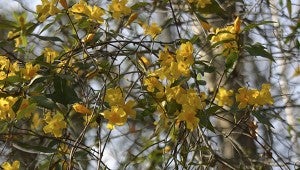Arboretum Paths: Mississippi’s native jewels are sparkling
Published 7:00 am Wednesday, March 5, 2014

Strands of gold: Have you been noticing strands of gold blossoms climbing up roadside trees and rambling over hedgerows? This is native Carolina jessamine vine.
Photo by Pat Drackett
Patricia Drackett
Director, Crosby Arboretum/ MSU Extension
Among the drab winter tree branches lining our local roadsides, perhaps you’ve seen a spot of color here and there, a glimpse of gold, a dash of red, or a burst of popcorn-like white blooms. These early spring flowers are so different from what we’ll be experiencing in another month or so, when the many shades of green and more garish colors will join the mix.
The scarlet reds you’ve been seeing in the forest are red maples (Acer rubrum). Notice the Latin species name? Ruby red they are. Many equate the red maple with the scarlet winged samaras that tumble to the ground, delighting children as they spin and dance in the air. But before the samaras appear, red maples are hard at work producing an abundant crop of red flowers.
The early blooms are not just beautiful to look at. Although red maple flowers are basically wind-pollinated, their sweet scent also attracts insects such as bees, flies, moths, and wasp. A variety of unfolding blooms beckon insects to stop and “sip a spell.”
Insects often perform the valuable service of pollinating the plants they visit. In turn, many critters feast on these insects, such as black bears, snakes, and wild turkeys.
Another early spring flower is Carolina yellow jessamine vine (Gelsemium sempervirens). It twines up the trunks of pine trees and scrambles over the tops of thickets, sometimes mixing with greenbriar (Smilax) vines. If you were a bird searching for a place to locate a nest, you would appreciate this habitat and the thick cover of the evergreen jessamine leaves mixed with the thorny Smilax.
Easy to grow, Carolina jessamine is beautiful rambling up a trellis or arbor. It does well in full sun to part shade, and is attractive to butterflies. One of my former employers created a cool, shady nook for a hammock by covering a pergola with dense-growing jessamine vine, making it a wonderful refuge on hot summer days.
On a ride north up Interstate 59 from Slidell, you can see areas in the swamp forest exploding with the white blooms of mayhaw (Crataegus opaca), an understory tree that grows in low woods and bottomland areas. It also does well in cultivation on upland sites, producing “haws” legendary for tasty jelly.
Elliott’s blueberry, (Vaccinium elliottii) has lacy green branches and is found growing along woodland edges or near the bases of trees. It is called “huckleberry” or “mayberry” by locals, producing small sweet blueberries that are excellent in pancakes or muffins. A particularly nice specimen is found on the loop drive behind our visitor center, where hundreds of tiny bell-shaped blossoms are beckoning to passing bees.
What all four of these plants have in common, besides possessing attractive early spring blooms, is that they are outstanding no-fuss native plants for the home landscape. Red maple always seems to have some part that glows with a red hue, from spring to autumn. Yellow jessamine is a dependable low-maintenance vine, mayhaws make a great flowering specimen tree, and Elliott’s blueberry is an attractive, delicate shrub in all seasons. Why not try a few of them in your home garden?
Our Spring Native Plant Sale will be held on Friday and Saturday, March 21 and 22, from 10a.m. to 3 p.m. Many hard-to-find native plants will be available for your «planting pleasure», as well as experts to help guide you in choosing the right plants for your property. This will be a day of free site admission, so bring your family and friends to enjoy a walk around the Arboretum.
We still have several seats left in our Gourdcrafting Workshop with artist Janet Schlauderaff on Saturday, March 8, from 10 a.m. to noon. Learn to create your own beautiful and unique designs with gourds. Cost is $4 for members and $6 for non-members.
Dr. Doug Tallamy, author of Bringing Nature Home: How Native Plants Sustain Wildlife in Our Gardens, will be the featured speaker of the annual Crosby Arboretum Lecture Series on March 15, from 10:00 to 11:30 a.m., at the Margaret Reed Crosby Memorial Library in Picayune. The cost is $5 for non-members. Call the office to reserve your seat.
For more information, call the Crosby Arboretum office at (601) 799-2311 or visit our website at www.crosbyarboretum.msstate.edu. We are open Wednesday through Sunday from 9 a.m. to 5 p.m. and located in Picayune, off I-59 Exit 4, at 370 Ridge Road (south of Walmart and adjacent to I-59).
FOR FURTHER EXPLORATION:
For more information on these plant species, visit the Native Plant Data Base on the Crosby Arboretum website, or search by species at www.MSUcares, the Mississippi State University Extension Service website.


